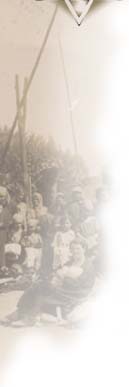|
|
|||||||||||||
|
|
|
|
|
|
|
||||||||
|
Life and Activities of the Jews in Žemaičių Naumiestis Supposedly, the Jews could settle down in Žemaičių Naumiestis around the year 1527, during the times of Kęsgailos or Zygnmunt I.. The Jewish community numbered around one thousand in the year 1531, and they had a primary school was functioning in the town. The synagogue was built in 1616. In 1810, there were 165 houses with 1600 residents in the town of Žemaičių Naumiestis, the majority of whom were Jews. The number of population was growing, and 2445 people, 1438 of whom were Jews, lived in the town in 1897. The population of Jews in Žemaičių Naumiestis before World War I was 1400 people. The number dropped to 664 in 1923. The Jews of Žemaičių Naumiestis lived in the central part of the town (today Laisvės and Pergalės Squares) and in the adjacent streets (Klaipėdos, Sodų, Birutės, Žaliojo kalno, Žemaitės streets). Žemaičių Naumiestis had been known as a trading centre since old times. Every year several fairs were held there, Wednesday and Friday were market days there. The trade and shops were mostly handled by Jews: 22 shops of the total 33 were owned by Jews. They kept shops selling ironware, cement, shoes, watches and clocks, jewellery, breadstuffs, chandlery, and they had a warehouse. There were a Jewish restaurant, a beerhouse, a teahouse, a hotel and a bank in the town. The Jews bought up skins, cattle, grain, poultry, eggs, butter. Although they had little land plots and gardens near their houses, none of them was involved in land work and farming. They mostly mended bicycles, sewed caps and took passengers to Vilnius. They had their own doctor and a pharmacy, a healer who owned a little shop selling various herbs and giving advice on treatment. Apart from a synagogue, the Jews had a little meeting-house for their gatherings in winter time, as the synagogue was not heated then. There were also a primary school, a bathhouse and a slaughter house. This life of Jews was shaken by the Second World War. The local Jews were killed in the hollow of Šiaudvyčiai in the summer of 1941. The Germans were assisted by some Lithuanians in the massacre. There can be no words found to justify the cruelty. The town has three Jewish cemeteries: the oldest one is in J.Žemaitės Street, the old one is in Klaipėda Street, and the genocide cemetery is in the village of Šiaudvyčiai The residents of Žemaičių Naumiestis have preserved the memories of the life of Jews in the town and they have provided plenty of information.
|
|||||||||||||

